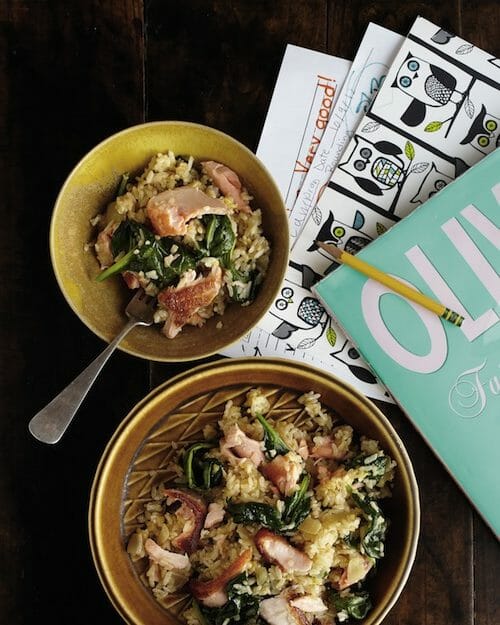Rice was one of very few grains to grace our dinner table when I was a kid. We didn’t eat wheat berries or bulgur, farro or freekah. When it came to starch at supper, it was bread, potatoes, or rice (with an occasional barley soup in the mix). Rice and rice alone was what my mother ritually fed us on Wednesdays during Lent as a way to remember the poor and suffering. The fact that Rice-A-Roni was the “San Francisco Treat” was a particular thrill for me and my siblings since we lived in the shadow of that fine city.
This month, I’m naming rice our “Miss August” as part of my Year of Whole Grains series. I figure we’re overdue for a dose of the familiar after I hoisted those somewhat obsure Sorghum Burrito Bowls on you in July.
Rice is the opposite of obscure. In fact, it’s a staple food for half the world’s population. The white rice you’ll find inside a box of Chinese takeout is but a fraction of the variety that fills the bellies of rice lovers from Bali to Barcelona. Indeed, the planet plays host to approximately 40,000 varieties of rice, a grain that is cultivated on every continent of the globe except Antarctica.
Most of us in the U.S. were raised on white rice, but I suggest shifting on over to whole grain rice, if you haven’t done so already. It’s got more texture and flavor than white rice (in my humble opinion) and is superior from a nutrition standpoint. Whole grain rice hasn’t been stripped of its bran and germ, which means more fiber, nutrients, and phytochemicals. All good things.
When it comes to whole grain rice, there’s a wide world of choices beyond garden variety brown. Chinese black rice, Himalayan red rice, and purple Thai rice are among the richly-hued whole grain rice options you’ll find in the marketplace these days.
Now for the downside. Arsenic. What!!! Over the past couple of years, researchers have found troubling levels of arsenic in rice, likely originating from the soil in which it’s grown. Has this knowledge put the brakes on my rice intake? No. But it is one more argument for why the healthiest diet is a varied one. I continue to include rice on the family table (probably every week or so), but in balance with loads of other whole grains.
To minimize arsenic levels, be sure to rinse your rice thoroughly before cooking. Also, consider cooking it as you would pasta, in a generous amount of water. According to the FDA, simmering the grain in a ratio of six parts water to one part rice can cut the arsenic by more than 50 percent. Here’s a little “how to” on the method from the folks over at The Kitchn.
Now that we have that unsavory business out of the way, let’s move onto something entirely savory (and delicious): Fried rice. The recipe comes from the mega-charming cookbook, KEEPERS by Caroline Campion and Kathy Brennan.
The book is a collection of fabulous family recipes that is, in itself, a keeper. Expat Fried Rice caught my eye because it makes great use of leftovers, can be pulled together in minutes, and is a healthy fried rice. Plus, unlike the name “fried rice” implies, it’s actually quite nourishing, particularly if you lean on whole grain rice and up the amount of vegetables (I used 2 cups each of greens and broccoli and it worked beautifully).
Expat Fried Rice
Ingredients
- 3 tablespoons canola oil or other vegetable oil
- 1 small yellow onion, finely chopped
- 4 cups cooked and cooled rice
- 2 large eggs
- 1 ½ cups bite-size pieces cooked meat or fish
- 2 cups packed baby spinach, 1 cup cooked small broccoli florets, or ½ cup frozen peas, thawed (see notes)
- Leaves from 2 sprigs thyme
- 3 tablespoons oyster sauce, plus extra, if needed
Instructions
-
In a wok or large skillet, heat the oil over high heat until it shimmers. Add the onions and cook, stirring often, until they start to brown but are still crisp, about 1 minute. Add the rice and heat through, breaking up any chunks and mixing the grains with the oil and onions, about 2 minutes.
-
Crack the eggs onto the rice and cook until almost set, stirring to break up the yolks and coat the rice, about 1 minute. Add the meat or fish and vegetables and heat through, stirring often, about 2 minutes. Add the thyme and oyster sauce and cook for about 1 minute more, stirring often. Check the seasonings, adding salt or more oyster sauce if needed, then serve hot.
Recipe Notes
You can use different vegetables and/or scale up the amount used. For example, I made this with 2 cups of broccoli and 2 cups of baby kale.
Recipe and photo used with permission from KEEPERS (Rodale, 2013) by Caroline Campion and Kathy Brennan. Photo credit: Christopher Testani.
